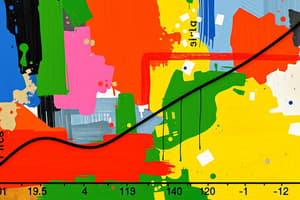Podcast
Questions and Answers
The price elasticity of demand coefficient measures:
The price elasticity of demand coefficient measures:
- Buyer responsiveness to price changes (correct)
- How far business executives can stretch their fixed costs
- The extent to which a demand curve shifts as incomes change
- The slope of the demand curve
The basic formula for the price elasticity of demand coefficient is:
The basic formula for the price elasticity of demand coefficient is:
- Percentage change in price/percentage change in quantity demanded
- Percentage change in quantity demanded/percentage change in price (correct)
- Absolute decline in price/absolute increase in quantity demanded
- Absolute decline in quantity demanded/absolute increase in price
The demand for a product is inelastic with respect to price if:
The demand for a product is inelastic with respect to price if:
- The elasticity coefficient is greater than 1
- A drop in price is accompanied by a decrease in the quantity demanded
- Consumers are largely unresponsive to a per unit price change (correct)
- A drop in price is accompanied by an increase in the quantity demanded
If the price elasticity of demand for a product is 2.5, then a price cut from $2.00 to $1.80 will:
If the price elasticity of demand for a product is 2.5, then a price cut from $2.00 to $1.80 will:
Suppose that as the price of Y falls from $2.00 to $1.90 the quantity of Y demanded increases from 110 to 118. Then the price elasticity of demand is:
Suppose that as the price of Y falls from $2.00 to $1.90 the quantity of Y demanded increases from 110 to 118. Then the price elasticity of demand is:
Which of the following is not characteristic of the demand for a commodity that is elastic?
Which of the following is not characteristic of the demand for a commodity that is elastic?
If the demand for product X is inelastic, a 4 percent increase in the price of X will:
If the demand for product X is inelastic, a 4 percent increase in the price of X will:
If a firm can sell 3,000 units of product A at $10 per unit and 5,000 at $8, then:
If a firm can sell 3,000 units of product A at $10 per unit and 5,000 at $8, then:
A perfectly inelastic demand schedule:
A perfectly inelastic demand schedule:
The larger the coefficient of price elasticity of demand for a product, the:
The larger the coefficient of price elasticity of demand for a product, the:
Most demand curves are relatively elastic in the upper-left portion because the original price:
Most demand curves are relatively elastic in the upper-left portion because the original price:
The price elasticity of demand for widgets is 0.80. Assuming no change in the demand curve for widgets, a 16 percent increase in sales implies a:
The price elasticity of demand for widgets is 0.80. Assuming no change in the demand curve for widgets, a 16 percent increase in sales implies a:
Suppose Aiyanna's pizzeria currently faces a linear demand curve and is charging a very high price per pizza and doing very little business. Aiyanna now decides to lower pizza prices by 5 percent per week for an indefinite period of time. We can expect that each successive week:
Suppose Aiyanna's pizzeria currently faces a linear demand curve and is charging a very high price per pizza and doing very little business. Aiyanna now decides to lower pizza prices by 5 percent per week for an indefinite period of time. We can expect that each successive week:
The price elasticity of demand of a straight-line demand curve is:
The price elasticity of demand of a straight-line demand curve is:
A leftward shift in the supply curve of product X will increase equilibrium price to a greater extent the:
A leftward shift in the supply curve of product X will increase equilibrium price to a greater extent the:
If the demand for bacon is relatively elastic, a 10 percent decline in the price of bacon will:
If the demand for bacon is relatively elastic, a 10 percent decline in the price of bacon will:
The price elasticity of demand is:
The price elasticity of demand is:
For a linear demand curve:
For a linear demand curve:
The price of product X is reduced from $100 to $90 and, as a result, the quantity demanded increases from 50 to 60 units. Therefore demand for X in this price range:
The price of product X is reduced from $100 to $90 and, as a result, the quantity demanded increases from 50 to 60 units. Therefore demand for X in this price range:
Suppose we find that the price elasticity of demand for a product is 3.5 when its price is increased by 2 percent. We can conclude that quantity demanded:
Suppose we find that the price elasticity of demand for a product is 3.5 when its price is increased by 2 percent. We can conclude that quantity demanded:
The price elasticity of demand for beef is about 0.60. Other things equal, this means that a 20 percent increase in the price of beef will cause the quantity of beef demanded to:
The price elasticity of demand for beef is about 0.60. Other things equal, this means that a 20 percent increase in the price of beef will cause the quantity of beef demanded to:
The elasticity of demand:
The elasticity of demand:
If a demand for a product is elastic, the value of the price elasticity coefficient is:
If a demand for a product is elastic, the value of the price elasticity coefficient is:
The concept of price elasticity of demand measures:
The concept of price elasticity of demand measures:
Suppose the price of local cable TV service increased from $16.20 to $19.80 and as a result the number of cable subscribers decreased from 224,000 to 176,000. Along this portion of the demand curve, price elasticity of demand is:
Suppose the price of local cable TV service increased from $16.20 to $19.80 and as a result the number of cable subscribers decreased from 224,000 to 176,000. Along this portion of the demand curve, price elasticity of demand is:
If the price of hand calculators falls from $10 to $9 and, as a result, the quantity demanded increases from 100 to 125, then:
If the price of hand calculators falls from $10 to $9 and, as a result, the quantity demanded increases from 100 to 125, then:
A perfectly inelastic demand curve:
A perfectly inelastic demand curve:
Moving upward on a downward-sloping straight-line demand curve, we find that price elasticity:
Moving upward on a downward-sloping straight-line demand curve, we find that price elasticity:
If the price elasticity of demand for gasoline is 0.20:
If the price elasticity of demand for gasoline is 0.20:
In which price range of the accompanying demand schedule is demand elastic?
In which price range of the accompanying demand schedule is demand elastic?
When the percentage change in price is greater than the resulting percentage change in quantity demanded:
When the percentage change in price is greater than the resulting percentage change in quantity demanded:
Suppose the price elasticity coefficients of demand are 1.43, 0.67, 1.11, and 0.29 for products W, X, Y, and Z respectively. A 1 percent decrease in price will increase total revenue in the case(s) of:
Suppose the price elasticity coefficients of demand are 1.43, 0.67, 1.11, and 0.29 for products W, X, Y, and Z respectively. A 1 percent decrease in price will increase total revenue in the case(s) of:
Which of the following statements is not correct?
Which of the following statements is not correct?
In which of the following instances will total revenue decline?
In which of the following instances will total revenue decline?
If a firm's demand for labor is elastic, a union-negotiated wage increase will:
If a firm's demand for labor is elastic, a union-negotiated wage increase will:
Flashcards are hidden until you start studying
Study Notes
Price Elasticity of Demand Concepts
- The price elasticity of demand (PED) coefficient indicates buyer responsiveness to price changes.
- PED is calculated using the formula: percentage change in quantity demanded / percentage change in price.
Demand Characteristics
- Inelastic demand signifies that consumers are largely unresponsive to price changes (elasticity coefficient less than 1).
- The demand curve for a product is elastic if the relative change in quantity demanded surpasses the relative change in price (elasticity coefficient greater than 1).
PED Values and Effects
- A price cut when PED is 2.5 increases quantity demanded by approximately 25%.
- If demand is inelastic, a price increase leads to less than proportional decrease in quantity demanded.
- A perfectly inelastic demand curve can be graphically represented by a vertical line (parallel to the vertical axis).
Revenue and PED Relationships
- Total revenue increases when the price is lowered if the demand is elastic; it decreases if the demand is inelastic.
- The larger the price elasticity coefficient, the smaller the resulting price change for an increase in supply.
Linear Demand Curves
- Elasticity is not constant along a linear demand curve; it varies based on price levels, generally becoming more elastic at higher prices.
Implications of Price Changes
- When the price of a good falls significantly, and demand is elastic, the quantity demanded increases by a larger percentage than the price decrease.
- Conversely, for inelastic goods, quantity demanded changes less than the price change during price fluctuations.
Demand Schedules
- Analyzing demand schedules helps identify in which price range demand is elastic or inelastic.
- A leftward shift in the supply curve causes greater increases in equilibrium price when demand is more inelastic.
Total Revenue and Elasticity
- Total revenue outcomes can be predicted based on demand elasticity. A decline in price for elastic goods usually increases total revenue, while it decreases for inelastic goods.
Misunderstandings About Elasticity
- Often misinterpreted, a statement that demand remains inelastic if price changes do not affect the quantity demanded at all is incorrect. Demand can exhibit both elastic and inelastic characteristics depending on the price and context.
Studying That Suits You
Use AI to generate personalized quizzes and flashcards to suit your learning preferences.




